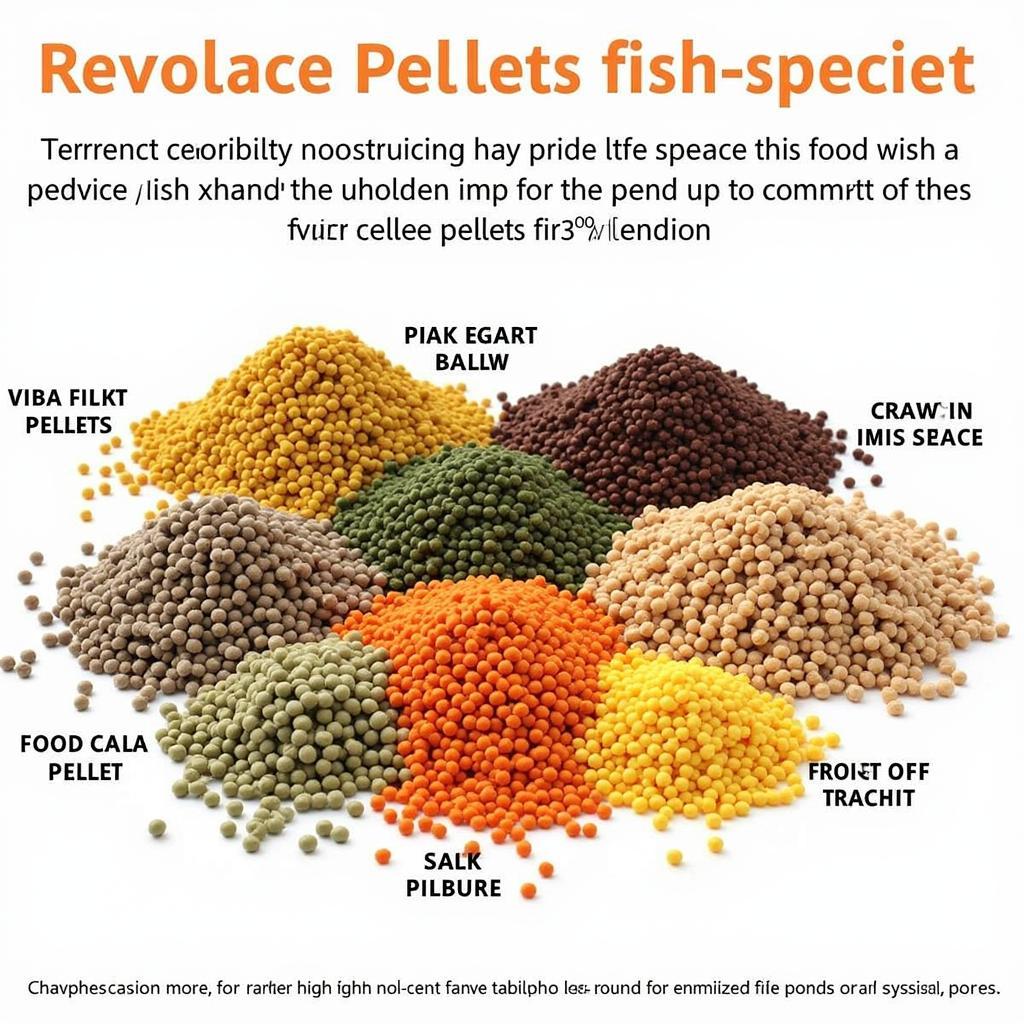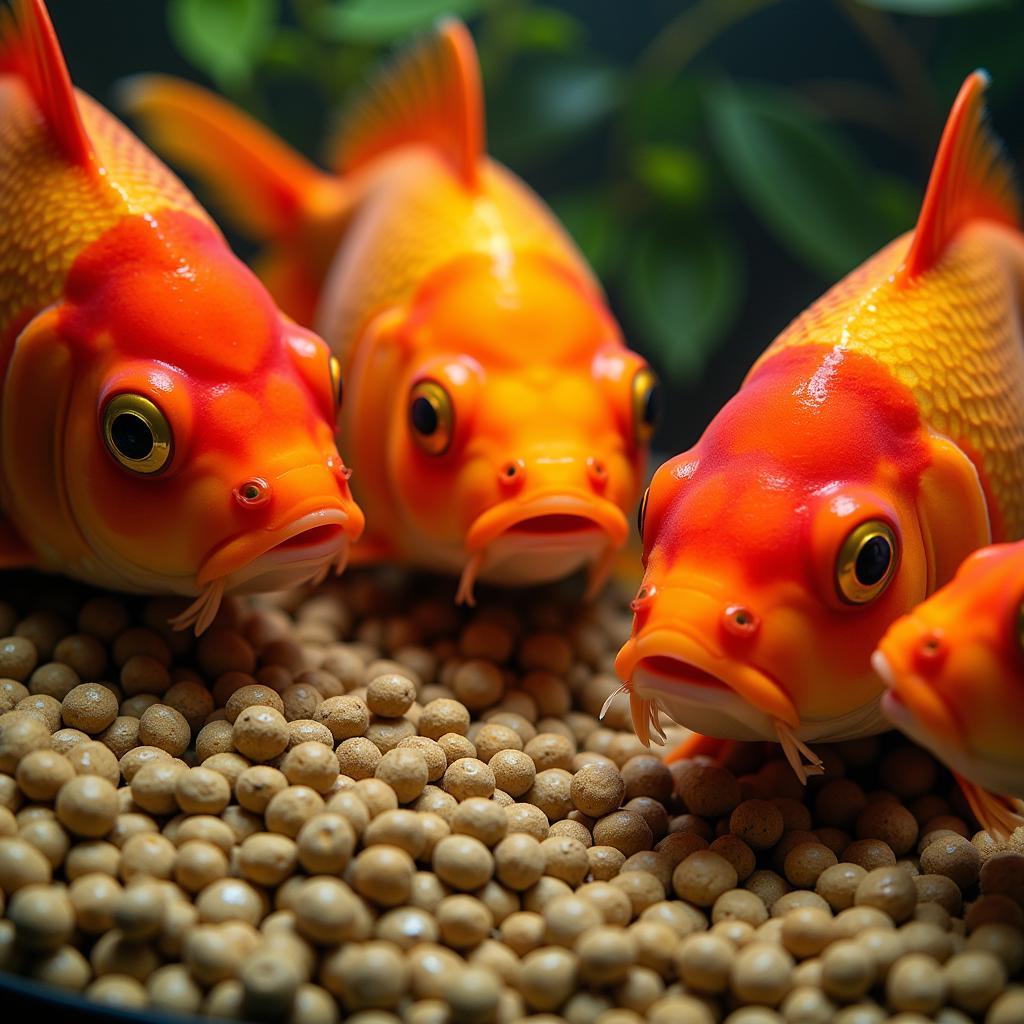Maintaining a healthy and vibrant pond requires providing your fish with the proper nutrition. Fish Food Pellets For Ponds offer a convenient and complete diet, ensuring your finned friends thrive. This guide will delve into everything you need to know about choosing and using fish food pellets, helping you create a flourishing aquatic ecosystem.
Understanding the Importance of Quality Fish Food Pellets
Choosing the right fish food pellets is crucial for the overall health and well-being of your pond fish. High-quality pellets provide essential nutrients, promoting growth, boosting immunity, and enhancing color vibrancy. Poor-quality pellets, on the other hand, can lead to digestive issues, stunted growth, and a weakened immune system, making fish more susceptible to diseases. Investing in premium fish food brands ensures your fish receive the optimal nutrition they need.
Choosing the Right Fish Food Pellets for Your Pond
With so many varieties of fish food pellets available, selecting the right one can seem overwhelming. Consider the following factors to make an informed decision:
- Fish Species: Different fish species have different dietary requirements. For example, koi require a higher protein diet compared to goldfish. Research the specific needs of your fish species to choose appropriate pellets.
- Water Temperature: Water temperature affects fish metabolism. In warmer water, fish require more food, while in colder water, their metabolism slows down. Choose pellets formulated for the specific temperature range of your pond.
- Pellet Size: Pellet size should be appropriate for the size of your fish. Smaller fish require smaller pellets, while larger fish can handle larger sizes. Offering the correct pellet size ensures efficient digestion and minimizes waste.
- Ingredients: Look for pellets made with high-quality ingredients, such as fish meal, whole grains, and essential vitamins and minerals. Avoid pellets with fillers or artificial colors.
 Variety of fish food pellets for different fish species and pond conditions
Variety of fish food pellets for different fish species and pond conditions
Feeding Your Pond Fish with Pellets
Proper feeding techniques are just as important as choosing the right pellets. Overfeeding can lead to water quality issues, while underfeeding can result in malnutrition. Follow these guidelines for optimal feeding:
- Feeding Frequency: Feed your fish once or twice a day, offering only the amount they can consume within a few minutes. Avoid leaving uneaten food in the pond, as it can decompose and pollute the water.
- Feeding Location: Establish a designated feeding area in your pond to make it easier to monitor feeding and clean up any uneaten pellets.
- Seasonal Adjustments: Adjust feeding frequency and quantity based on the season. Fish require less food in colder months when their metabolism slows down.
- Monitoring Fish Behavior: Observe your fish after feeding. If they are actively consuming the pellets and appear healthy, your feeding strategy is likely effective.
Benefits of Using Fish Food Pellets for Ponds
Fish food pellets offer numerous advantages for pond owners:
- Nutritional Completeness: High-quality pellets provide a balanced diet with all the essential nutrients fish need for optimal health and growth.
- Convenience: Pellets are easy to store and dispense, making feeding a simple and efficient process.
- Water Quality Management: Properly sized pellets minimize waste and reduce the risk of water pollution.
- Cost-Effectiveness: Fish food pond bulk purchases can significantly reduce costs, especially for larger ponds.
You might also consider specific food options, such as bluegill food if you have those in your pond.
Common Questions About Fish Food Pellets for Ponds
What are the different types of fish food pellets available? Fish food pellets come in various formulations, including floating, sinking, and slow-sinking varieties, catering to different fish species and feeding habits.
How much should I feed my pond fish? The amount of food depends on factors like fish species, size, water temperature, and activity level. Start with a small amount and adjust based on how much your fish consume within a few minutes.
Can I feed my pond fish other foods besides pellets? Yes, you can supplement their diet with occasional treats like insects, worms, and vegetables. However, pellets should form the basis of their nutrition.
How do I store fish food pellets? Store pellets in a cool, dry place, away from direct sunlight and moisture, to maintain their freshness and nutritional value.
What if my fish aren’t eating the pellets? Check the water quality, temperature, and pellet size. It’s also possible your fish may prefer a different type or brand of pellet.
Are fish food pellets suitable for all pond fish? Most pond fish thrive on a pellet-based diet. However, some species, like bottom feeders, may require sinking pellets.
How can I tell if my fish food pellets are high quality? Look for pellets from reputable fish food brands with clear ingredient lists and a focus on nutritional value.
 Healthy pond fish consuming fish food pellets
Healthy pond fish consuming fish food pellets
Conclusion
Choosing the right fish food pellets for ponds is a vital aspect of responsible pond ownership. By understanding your fish’s needs and following proper feeding practices, you can ensure a healthy and thriving aquatic environment. High-quality fish food pellets for ponds provide a convenient, cost-effective, and nutritionally complete solution for keeping your fish happy and vibrant. If you also have bass in your pond, you might be interested in learning more about bass food for ponds. Some pond owners also have turtles, and for their needs, you can check out food for turtles in ponds.
For further support, contact us at Phone Number: 02437655121, Email: minacones@gmail.com Or visit us at: 3PGH+8R9, ĐT70A, thôn Trung, Bắc Từ Liêm, Hà Nội, Việt Nam. We have a 24/7 customer service team.